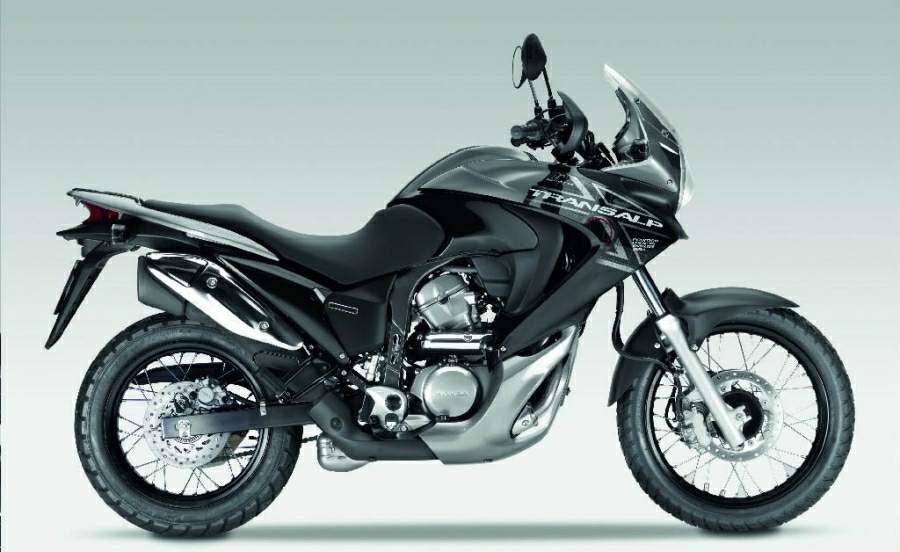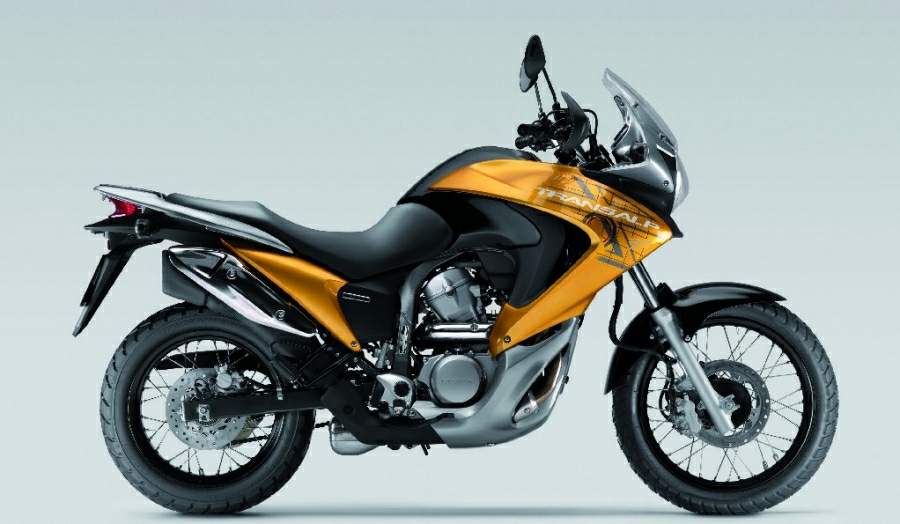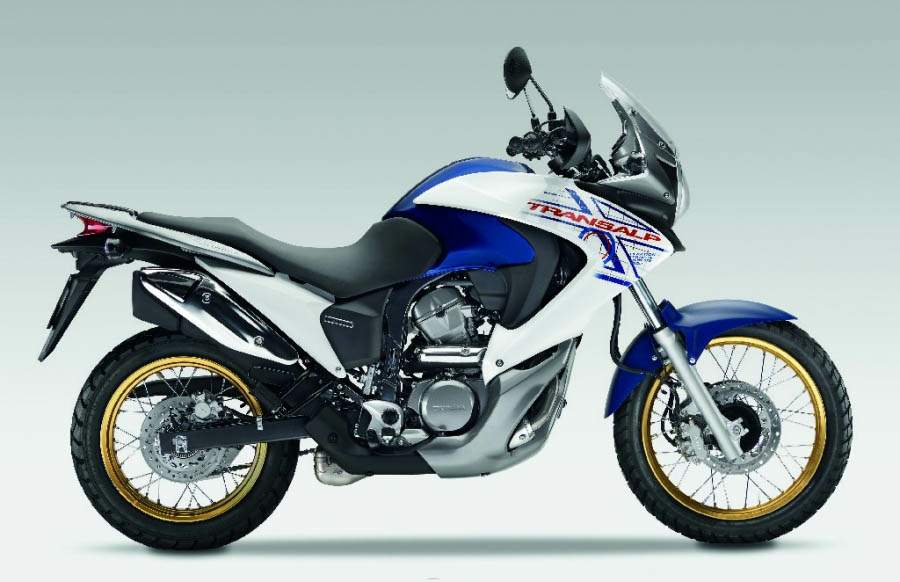
|
|
|
|
|
|
Classic Bikes
Custom Bikes
Individual
Racing Bikes AJP
AJS
Aprilia
Ariel
Avinton / Wakan
Bajaj
Benelli
Beta
Bimota
BMW
Brough Superior
BRP Cam-Am
BSA
Buell / EBR
Bultaco
Cagiva
Campagna
CCM
CF Moto
Combat Motors
Derbi
Deus
Ducati
Excelsior
GASGAS
Ghezzi Brian
Gilera
GIMA
Harley Davidson
Hero
Highland
Honda
Horex
Husaberg
Husqvarna
Hyosung
Indian
Jawa
Kawasaki
KTM
KYMCO
Laverda
Lazareth
Magni
Maico
Mash
Matchless
Mondial
Moto Guzzi
Moto Morini
MV Agusta
MZ / MuZ
NCR
Norton
NSU
Paton
Peugeot
Piaggio
Revival Cycles
Roland Sands
Royal Enfield
Sachs
Sherco
Sunbeam
Suzuki
SWM
SYM
Triumph
TVS
Ural
Velocette
Vespa
Victory
Vincent
VOR
Voxan
Vyrus
Walt Siegl
Walz
Wrenchmonkees
Wunderlich
XTR / Radical
Yamaha
Zero
Video
Technical
Complete Manufacturer List
|
Honda XL 700V Transalp |
| . |
|
Make Model |
Honda XL 700V Transalp |
|
Year |
2009 - 10 |
|
Engine |
Four stroke, 52o V-Twin, SOHC, 4 valves per cylinder |
|
Capacity |
680.2 cc / 41.5 cu-in |
| Bore x Stroke | 81 x 66 mm |
| Cooling System | Liquid cooled |
| Compression Ratio | 10.0:1 |
| Lubrication | Wet sump |
|
Induction |
Electronic fuel injection 40mm throttle bodies |
|
Ignition |
Digital transistorized |
| Spark Plug | NGK, DPR8EA-9 |
| Starting | Electric |
|
Max Power |
59.1 hp / 44 kW @ 7750 rpm |
|
Max Torque |
60 Nm / 44.3 ft.lbs @ 5500 rpm |
| Clutch | Wet, multiple discs, cable operated |
|
Transmission |
5 Speed |
| Final Drive | Chain |
| Frame | Aluminium, Trellis frame |
|
Front Suspension |
41 mm leading-axle fork |
| Front Wheel Travel | 177 mm / 7.9 in |
| Rear Suspension | Pro-Link with adjustable compression damping |
| Rear Wheel Travel | 173 mm / 6.8 in |
|
Front Brakes |
2x 256 mm discs 2 piston calipers |
|
Rear Brakes |
Single 240 mm disc 1 piston caliper |
|
Front Tyre |
100/90 -19 |
|
Rear Tyre |
130/80 -17 |
| Dimensions |
Length 2250 mm / 88.6 in Height 1305 mm / 51.3 in Width 905 mm / 35.6 in |
| Wheelbase | 1,515 mm / 59.6 lbs |
| Seat Height | 841 mm / 33.1 in |
| Ground Clearance | 177 mm / 7.0 in |
|
Dry-Weight |
214 kg / 472 lbs |
|
Fuel Capacity |
17.5 Litres / 4.6 US gal |
| Consumption Average | 19.2 km/lit |
|
Standing ¼ Mile |
13.5 sec |
|
Top Speed |
173.0 km/h / 107.4 mph |
| . |
Honda has prepared the notorious Transalp for 2009 as part of their plans to continue the long career of this average displacement Enduro bike, but only added anti-lock brakes and painted it in the colors of the first Transalp model.
Already famous thanks to its bulletproof engine and the awesome riding experience that it offers both on paved roads and off them, the Honda XL700V Transalp needs no presentation whatsoever. What is unknown on this new model is the C-ABS anti-lock brakes that are meant to provide the best of braking performance on all riding surfaces that the bike is made to be exploited on. Honda added the new braking system on most bikes in the 2009 lineup and this legend simply couldn’t be missed.
Featuring an aggressive and futuristic design, the Transalp practically defines through its looks the idea of adventure in motorcycling, meaning no barriers in a rider’s quest. And the liquid-cooled and electronically fuel-injected 680cc V-Twin four-valved engine is there to back up the inviting design and never leave room for the rider to wish another kind of riding experience. This is the impressive result of the V-Twin engine type which managed to find its way on this dual-sport motorcycle in 1987 together with the first Transalp. Imagine this bike’s evolution if it would have featured a single-cylinder motor.
Modern day means modern requirements so the new Honda has to comply with Euro-3 regulations and features a very efficient catalytic device.
Also, Honda offers a range of accessories which allow you to personalize the 2009 model year like never before. Not much has changed, indeed, but what did, makes all the difference.

Test Ride
Honda's Spanish-built, 643cc Transalp
adventure tourer has been around since 2000 but when time came for an update
the Honda guys didn't just give it a nip and tuck, they waved the corporate
magic wand and hola! – a whole new bike. Well, almost…
They started with a longer stroke (79 up to 81mm) to take capacity up to
680cc, claimed max power from 39 to 44.1kW at 7750 and torque from 55 to
66Nm at 5500rpm. The 650's CV carbs have been replaced by electronic
fuel-injection with 40mm throttle bodies.
The new bike's mid-range is certainly stronger but the big improvement is in
induction; Honda seems to have conquered the jerkiness that afflicts most
fuel-injection systems at small throttle openings.
It will pick up smoothly and evenly from as low as 2750rpm.
The new Transalp will pick up smoothly from 2750rpm so it can be used as a balanced, if bulky, commuter.

Throttle response is, in fact, good throughout the rev range; as with most
Hondas, there's no power band as such, but the engine becomes more energetic –
and noticeably vibratious - above 6500rpm.
The Transalp romps happily up to its true top speed of 177km/h, the rev counter
needle hovering around the red line at 8000rpm, without any apparent stress,
although it becomes prone to mild weaving and headshakes above 160km/h –
especially if you have your feet on the rear footpegs, which seems to make it
much worse.
But this is not a sports bike, so back off to just under the vibration level at
6500rpm and the bike will cruise comfortably all day at around 150km/h
Sustained high speed
also makes the Transalp unexpectedly thirsty; our standard test ride, which
included performance testing, returned 7.3 liters
/100km – that's 11.3 percent
worse than that of the previous model despite Honda's claims to the
contrary.
The rest of the drive train is standard Honda issue – a slightly wooden but
seemingly abuse-proof clutch and a five-speed gearbox that works better at high
revs than poodling around town. The shift action of the test Transalp seemed
very notchy when the bike was cold – possibly due to its extreme youth.
The brakes are a little low-tech: sliding callipers at both ends but with plenty
power and bite to make the long-travel front suspension dive extravagantly under
hard braking, occasionally throwing a little wobble into the front end – use the
rear brake to steady the plot.
You soon learn to do all your braking before you get to a turn – then you can
float through at speed and come out with the throttle hard on.
Supple and well damped
The suspension is supple and well damped, ideal for a back-roads tourer if not
for a sports bike; it coped better with our bumpy test section than some pukka
dual-purpose bikes I've ridden there, holding its line and telling me about the
bumps without transferring them to my spine.
The Transalp is also at home on gravel, even though it has a smaller front wheel
than its predecessor; it's surefooted on hard surfaces but the Metzeler Tourance
semi-street tyres (30 years ago we'd have called them trials universals) soon
reached their limit in soft sand and mud.
Once again, this is a tourer, not an enduro bike.
The new fairing was a surprise on several levels; Honda claims it's smaller than
that of the 650 – well, it's wider at the crucial 1.5m level (roof height for
most cars – very important in traffic) but considerably slimmer above that.
Honda also says it deliberately sacrificed some protection for smoother airflow;
said airflow must be much smoother because, despite having more wind in my face
(and since when has that been a bad thing?), I found myself more relaxed at
cruising speed on the 700.

The styling is also more coherent and the graphics, which Honda says are
intended to evoke the readout of a GPS navigation system, are bright and
distinctive without being too plastic.
The new instrument panel is generically digital with an analogue rev-counter (it
seems the market just won't accept any other representation for engine speed)
but better laid-out than most in a very neat pod. There are numbers for time,
speed and distance and a bar graph for fuel, all very logical and legible.
The wide, flat seat is very deeply padded, as supportive as a commode cushion
and very comfortable once you're on the move; it's a little too wide at the
front when you have to put your feet down, however, not ideal especially as the
seat is already high at 841mm.
Relaxed and comfortable
The passenger accommodation is relaxed and comfortable but makes the bike a
little less than wieldy, the steering less precise. It's fine for giving She Who
Must Be Obeyed a lift to work in the mornings but for touring together you'd do
better getting her a Transalp of her own.
If I have a gripe it's that the bike could use a centre-stand – although that'll
make the saddle feel even higher.
Build quality from the Montesa plant near Barcelona is impressive and the
Transalp has a well-deserved reputation for durability. The XL700V is a great
round-towner, despite its wide bodywork – but it's even better on the back roads
taking you to places few people go.
Source Motoring 2008

|
Any corrections or more information on these motorcycles will be kindly appreciated. |